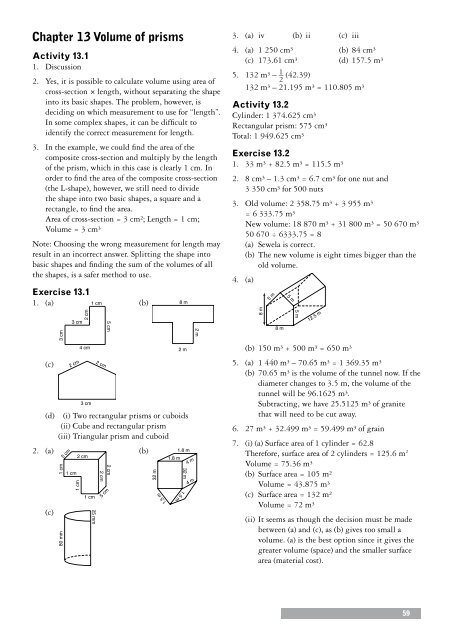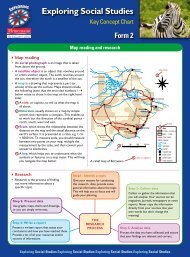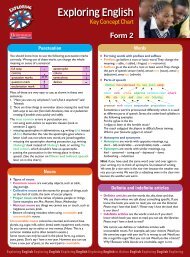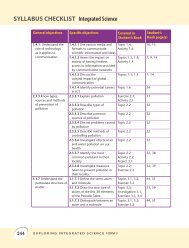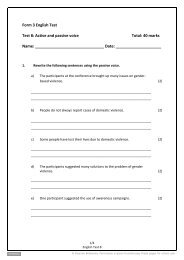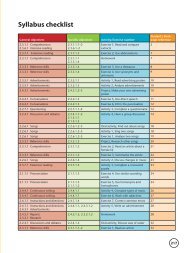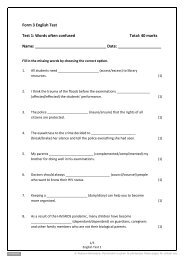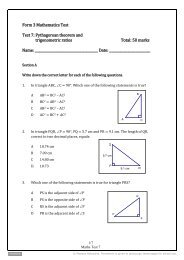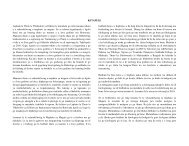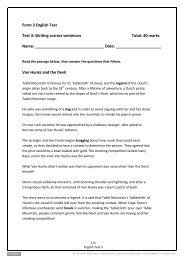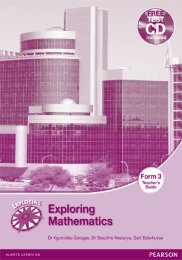Chapter 13 Volume of prisms
Chapter 13 Volume of prisms
Chapter 13 Volume of prisms
Create successful ePaper yourself
Turn your PDF publications into a flip-book with our unique Google optimized e-Paper software.
80 mm<br />
<strong>Chapter</strong> <strong>13</strong> <strong>Volume</strong> <strong>of</strong> <strong>prisms</strong><br />
Activity <strong>13</strong>.1<br />
1. Discussion<br />
2. Yes, it is possible to calculate volume using area <strong>of</strong><br />
cross-section × length, without separating the shape<br />
into its basic shapes. The problem, however, is<br />
deciding on which measurement to use for “length”.<br />
In some complex shapes, it can be difficult to<br />
identify the correct measurement for length.<br />
3. In the example, we could find the area <strong>of</strong> the<br />
composite cross-section and multiply by the length<br />
<strong>of</strong> the prism, which in this case is clearly 1 cm. In<br />
order to find the area <strong>of</strong> the composite cross-section<br />
(the L-shape), however, we still need to divide<br />
the shape into two basic shapes, a square and a<br />
rectangle, to find the area.<br />
Area <strong>of</strong> cross-section = 3 cm²; Length = 1 cm;<br />
<strong>Volume</strong> = 3 cm³<br />
Note: Choosing the wrong measurement for length may<br />
result in an incorrect answer. Splitting the shape into<br />
basic shapes and finding the sum <strong>of</strong> the volumes <strong>of</strong> all<br />
the shapes, is a safer method to use.<br />
Exercise <strong>13</strong>.1<br />
1. (a)<br />
(c)<br />
3 cm<br />
3 cm<br />
2 cm<br />
2 cm<br />
4 cm<br />
3 cm<br />
1 cm<br />
2 cm<br />
5 cm<br />
(b)<br />
8 m<br />
2 m<br />
(d) (i) Two rectangular <strong>prisms</strong> or cuboids<br />
(ii) Cube and rectangular prism<br />
(iii) Triangular prism and cuboid<br />
2. (a)<br />
(b)<br />
1.8 m<br />
(c)<br />
1 cm<br />
5 cm<br />
1 cm<br />
1 cm<br />
2 cm<br />
1 cm<br />
25 mm<br />
2 cm<br />
2 cm<br />
5 cm<br />
32 m<br />
1.5 m<br />
1.8 m<br />
1.5 m<br />
32 m<br />
4 m<br />
4 m<br />
2 m<br />
3. (a) iv (b) ii (c) iii<br />
4. (a) 1 250 cm³ (b) 84 cm³<br />
(c) 173.61 cm³ (d) 157.5 m³<br />
5. <strong>13</strong>2 m³ – __ 1 2 (42.39)<br />
<strong>13</strong>2 m³ – 21.195 m³ = 110.805 m³<br />
Activity <strong>13</strong>.2<br />
Cylinder: 1 374.625 cm³<br />
Rectangular prism: 575 cm³<br />
Total: 1 949.625 cm³<br />
Exercise <strong>13</strong>.2<br />
1. 33 m³ + 82.5 m³ = 115.5 m³<br />
2. 8 cm³ – 1.3 cm³ = 6.7 cm³ for one nut and<br />
3 350 cm³ for 500 nuts<br />
3. Old volume: 2 358.75 m³ + 3 955 m³<br />
= 6 333.75 m³<br />
New volume: 18 870 m³ + 31 800 m³ = 50 670 m³<br />
50 670 ÷ 6333.75 = 8<br />
(a) Sewela is correct.<br />
(b) The new volume is eight times bigger than the<br />
old volume.<br />
4. (a)<br />
8 m<br />
5 m<br />
8 m<br />
5 m<br />
5 m<br />
12.5 m<br />
(b) 150 m³ + 500 m³ = 650 m³<br />
5. (a) 1 440 m³ – 70.65 m³ = 1 369.35 m³<br />
(b) 70.65 m³ is the volume <strong>of</strong> the tunnel now. If the<br />
diameter changes to 3.5 m, the volume <strong>of</strong> the<br />
tunnel will be 96.1625 m³.<br />
Subtracting, we have 25.5125 m³ <strong>of</strong> granite<br />
that will need to be cut away.<br />
6. 27 m³ + 32.499 m³ = 59.499 m³ <strong>of</strong> grain<br />
7. (i) (a) Surface area <strong>of</strong> 1 cylinder = 62.8<br />
Therefore, surface area <strong>of</strong> 2 cylinders = 125.6 m 2<br />
<strong>Volume</strong> = 75.36 m³<br />
(b) Surface area = 105 m²<br />
<strong>Volume</strong> = 43.875 m³<br />
(c) Surface area = <strong>13</strong>2 m²<br />
<strong>Volume</strong> = 72 m³<br />
(ii) It seems as though the decision must be made<br />
between (a) and (c), as (b) gives too small a<br />
volume. (a) is the best option since it gives the<br />
greater volume (space) and the smaller surface<br />
area (material cost).<br />
59
8. (a) 1 350 m³ – 42.39 m³ = 1 307.61 m³<br />
<strong>of</strong> concrete<br />
(b) 42.39 m³<br />
(c) 9 000 m³ – 282.6 m³ = 8 717 m³ <strong>of</strong> concrete<br />
<strong>Volume</strong> <strong>of</strong> water = 282.6 m³<br />
9. (a) 4 m³ (b) 1 080 m³<br />
(c) 270 bales <strong>of</strong> hay<br />
10. (a) 9 450 m³ + 14 580 m³ + 11 340 m³<br />
= 35 370 m³<br />
(b) 35 370 m³ × 5 s/m³ = 176 850 s<br />
Divide by 60 to get minutes: 2947.50 min<br />
Divide by 60 to get hours: 49.125 h which is<br />
49 h rounded to the nearest whole number.<br />
Activity <strong>13</strong>.3<br />
1. (a) – (c)<br />
2. Discussion.<br />
Exercise <strong>13</strong>.3<br />
1.<br />
2. (a) – (b)<br />
60
3.<br />
4.<br />
5. (a) – (b)<br />
61
Activity <strong>13</strong>.4<br />
Exercise <strong>13</strong>.4<br />
1.<br />
2.<br />
62
3.<br />
4.<br />
5.<br />
63
Revision exercise<br />
1. 300 cm³<br />
2.<br />
3. (a) 1 371.6 cm³ (b) <strong>13</strong>7 160 cm³<br />
64
<strong>Chapter</strong> 14 Time, distance and<br />
speed<br />
Activity 14.1<br />
1. Answers will vary.<br />
2. In this case, there is no number (distance nor time)<br />
that is the same for both people. It is therefore<br />
difficult to work out mentally who was the fastest.<br />
The correct answer is Sewela. There is a detailed<br />
explanation in the Student’s Book.<br />
Exercise 14.1<br />
1. 50t coin = 0.2 m/s<br />
25t coin = 0.17 m/s<br />
2. 20 m/s<br />
3. (a) Between A and B: ______ 30 km<br />
= 1.5 km/min<br />
20 min<br />
Between B and C: 1.39 km/min<br />
Between C and D: 1.33 km/min<br />
(b) C and D<br />
(c) A and B<br />
4. (a) Kealaboga = 100 m/min or 1.67 m/s<br />
(b) Kabelo 50 m/40 s = 1.25 m/s<br />
(c) 0.42 metres faster per second<br />
5. 0.31 km/min<br />
6. (a) 6 km/h (b) 5.33 km/h<br />
7. 23.3 km/h<br />
8. (a) 70 km/h – Mr Koloi<br />
72 km/h – Mrs Dube<br />
Mr Koloi was going 10 km over the<br />
speed limit.<br />
Mrs Dube was going 12 km over the<br />
speed limit.<br />
(b) P160<br />
9. (a) 125 km/h (b) 112.5 km/h<br />
10. Set up the following equation:<br />
720 – 32x = 480 + 32x<br />
In this case, x stands for time in hours.<br />
Solving for x, the length <strong>of</strong> time is 3.75 h.<br />
This means that the aeroplane flies 720 km in<br />
3.75 h (with the wind) and 480 km in 3.75 h<br />
(against the wind).<br />
Faster speed: 720 km ÷ 3.75 h = 192 km/h<br />
Slower speed: 480 km ÷ 3.75 h = 128 km/h<br />
Therefore in STILL air, we either add or subtract the<br />
wind speed.<br />
Faster speed: 192 km/h – 32 km/h = 160 km/h<br />
Slower speed: 128 km/h + 32 km/h = 160 km/h<br />
Speed in still air = 160 km/h<br />
Exercise 14.2<br />
1. 0.75 cm/min 2. 1.14 km/min<br />
3. ________ 125 km<br />
= 125 km/6.5 h = 19.2 km/h<br />
6 h 30 min<br />
4. Banyana ____ 5 km<br />
1 h = 5 km/h<br />
Kitso ______ 8 km<br />
84 min = ____ 8 km = 5.7 km/h<br />
1.4 h<br />
Kitso walked faster.<br />
5. _____ 580 m<br />
= 20 m/s<br />
29 s<br />
6. 2 m/s<br />
7. 30 km/ 5.5 h = 5.45 km/h (rounded to 2 d.p.)<br />
8.<br />
Distance (km) Speed (km/h) Time (h)<br />
Bus d r 2<br />
Taxi d + 30 2r – 40 2<br />
r = __ d (Bus: Speed = _______ Distance<br />
2 Time )<br />
2r – 40 = _____ d + 30 (Taxi: Speed = _______<br />
2<br />
Distance<br />
Time )<br />
Substituting r = __ d we have:<br />
2<br />
2 __<br />
( d<br />
2 ) – 40 = _____ d + 30<br />
2<br />
[ d – 40 = _____ d + 30<br />
2<br />
[ 2d – 80 = d + 30<br />
[ d = 110<br />
Speed <strong>of</strong> bus = _______ Distance = ______ 110 km = 55 km/h<br />
Time 2 h<br />
Speed <strong>of</strong> taxi is twice the speed <strong>of</strong> the bus (55 × 2)<br />
and 40 km slower.<br />
= 110 km/h – 40 km/h = 70 km/h<br />
Activity 14.2<br />
Convert from Convert to Operation<br />
km m × 1 000<br />
m km ÷ 1 000<br />
m cm × 100<br />
cm m ÷ 100<br />
h min × 60<br />
min h ÷ 60<br />
min s × 60<br />
H s x 3 600<br />
s h ÷ 3 600<br />
Exercise 14.3<br />
(Teachers, a useful online velocity converter can be<br />
found at: www.translatorscafe.com)<br />
1. (a) iii (b) i (c) iii<br />
65
2.<br />
Convert from<br />
Convert to<br />
10 m/s 36 km/h<br />
120 km/h 33.33 m/s<br />
30 m/min 0.5 m/s<br />
100 cm/min 60 m/h<br />
3. It should have been ______ 3 600 s not _____ 360 s<br />
1 h 1 h .<br />
The correct answer is 36 km/h.<br />
4. 22.22 m/s 5. 9 km/h 6. 126 km/h<br />
7. 10.5 km/h<br />
2.92 m/s<br />
8. 120 km/h<br />
Activity 14.3<br />
1. 1 h 2. 2 h<br />
3. 16:00 4. 6 h<br />
5. 10:00 and 11:00. The graph is the steepest between<br />
these two times.<br />
6. A mark made at 14:30.<br />
Exercise 14.4<br />
1. (a) 08:20 (b) 20 min (c) 0.1 km/min<br />
(d) Faster (e) 08:50<br />
2. (a) 3 km (b) 1__<br />
2 h<br />
(c) Perhaps her friend was not home.<br />
(d) 1 h<br />
(e) 2.67 km/h (rounded to 2 d.p.)<br />
3. (a) 140 m (b) 06:03 (c) 80 s<br />
(d) 2 m/s (e) 0.78 m/s<br />
4. (a) Team Silver Stars (b) 250 km<br />
(c) Team Hot Shots (d) 3 h<br />
(e) 150 km<br />
(f) 100 km/h<br />
5. (a) 5 km<br />
(b) Skateboarder A stopped. Perhaps he fell and<br />
hurt himself.<br />
(c) 10 km/h (d) 07:15<br />
(e) 37.5 min<br />
(f) Skateboarder A won by 7.5min.<br />
6. Answers will vary.<br />
Exercise 14.5<br />
1. (a)<br />
Time <strong>of</strong><br />
day<br />
Distance<br />
from the start<br />
Time from<br />
the start<br />
Comments<br />
05:00 0 km 0 min Fetched sheep<br />
06:30 3 km 1.5 h Arrived at grazing<br />
area<br />
07:30 3 km 2.5 h Stopped<br />
09:00 0 km 4 h Arrived back at the<br />
farm<br />
(b)<br />
Distance (km)<br />
5<br />
4<br />
3<br />
2<br />
1<br />
Shepherd’s journey<br />
0<br />
05:00 05:30 06:00 06:30 07:00 07:30 08:00 08:30 09:00<br />
Time <strong>of</strong> day<br />
(c) 6 km/ 4 h = 1.5 m/h average speed<br />
2. (a)<br />
Tiro and father’s journey<br />
Distance (km)<br />
5<br />
4<br />
3<br />
2<br />
1<br />
0<br />
09:00 09:30 10:00 10:30 11:00 11:30 12:00<br />
Time <strong>of</strong> day<br />
(b) 30 min<br />
(c) 1 h<br />
(d) ____ 8 km = 2.7 km/h (to 2 d.p.)<br />
3 h<br />
(e) 12:00<br />
3. (a)<br />
The journey <strong>of</strong> the bee<br />
Distance (km)<br />
8<br />
7<br />
6<br />
5<br />
4<br />
3<br />
2<br />
1<br />
0<br />
0 5 10 15 20 25 30 35 40<br />
Time (min)<br />
(b) 15:00<br />
(c) 10 min<br />
(d) 0.5 km/min or 30 km/h<br />
66
4. (a)<br />
Distance (km)<br />
300<br />
250<br />
200<br />
150<br />
100<br />
Ambulances A and B’s journey<br />
A<br />
50<br />
B<br />
0<br />
0 1 2 3 4 5 6 7 8<br />
Time<br />
Revision exercise<br />
1. 116.67 km/h<br />
2. (a) 0.51 km/min (b) 30.67 km/h<br />
3. 6.25 m/s<br />
4. (a) 07:30 (b) 1 h<br />
(c) 4 km<br />
(d) 2 km/h<br />
5. 2.5 h<br />
6. 15 km + 24.75 km = 39.75 km<br />
5. (a)<br />
(b) 100 km; 1 h (c) 2 h<br />
(d) 4 h<br />
The fishing boat’s journey<br />
50<br />
Distance (km)<br />
40<br />
30<br />
20<br />
10<br />
0<br />
0 1 2 3 4 5 6 7 8<br />
Time (hours)<br />
(b) 10 km/h (c) 6:00 (d) 12:00<br />
Exercise 14.6<br />
1. 200 km<br />
2.<br />
100 m practice sprints<br />
Day Time Speed<br />
Monday 12 s 8.3333 m/s<br />
Tuesday 11 s 9.0909 m/s<br />
Wednesday 10.5 s 9.523 m/s<br />
Thursday <strong>13</strong> s 7.692 m/s<br />
Friday 10.5 s 9.523 m/s<br />
3. 4 h 4. 7 700 km<br />
5. 3 h 45 min<br />
6. He receives P105 from his mother for the<br />
21 km walk.<br />
He receives P73.50 from his grandfather.<br />
He raises P178.50 in total.<br />
7. (a) 90 km/h (b) 11__<br />
2 h<br />
(c) 45 km/h<br />
8. No, the tree is 26.25 m high.<br />
9. 52.5 s<br />
67
<strong>Chapter</strong> 15 Working with variables<br />
Activity 15.1<br />
1. (x – 5)²<br />
= (x – 5)(x – 5)<br />
= x² – 5x – 5x + 25<br />
= x² – 10x + 25<br />
2. They are both 5x.<br />
3. Find the product <strong>of</strong> the two terms in the expression,<br />
and double the product.<br />
Exercise 15.1<br />
1. (a) 3y + 18 (b) 4r² – 4r<br />
(c) 6e + 6f<br />
(d) 3a² + 3ab<br />
(e) m²n – mn² (f) 2u² – 2uv<br />
(g) 16k – 8jk<br />
(h) 4pr² + 28p²r<br />
(i) 30i + 6i²<br />
(j) 8yk + 8y + 8yx<br />
2. (a) 10a + 4 (b) 4tr + 42t + 2r<br />
(c) 7m² + 2m<br />
(d) 8u² – <strong>13</strong>u<br />
(e) 2rs + 4rt + 4ru (f) 12y² – 3y – 12<br />
(g) 3b² + 26ab – 10a² (h) –3e² + <strong>13</strong>e – 28<br />
(i) –3t² + 5t (j) 4xm²n – 14x²<br />
3. (a) 6r (b) 24t (c) –12ab (d) –24yz<br />
4. (a) a² + 2a + 1 (b) b² + 6b + 9<br />
(c) x² + 2xy + y² (d) 9d² + 12de + 4e²<br />
(e) f² – 12f + 36 (f) g² – 2gh + h²<br />
(g) 9d² – 12de + 4e² (h) 49p² –28pq + 4q²<br />
(i) 25t² + 60t + 36 (j) 144r² + 72rs + 9s²<br />
5. 49p 4 + 14p²q + q²<br />
6. (a) (7x + 3)² (Any variable can be used.)<br />
(b) 49x² + 42x + 9<br />
7. (a) x² + 2x + 1 (b) y² – 6y + 9<br />
(c) 4x² + 12x + 9 (d) 16x² + 8xy + y²<br />
(e) 9x² + 18xy + 9y² (f) 64x² – 32xy + 4y²<br />
(g) 16y² – 8xy + x²<br />
(h) 121x² + 264xy + 144y²<br />
(i) 64x² + 112xy + 49y² (j) 25y² + 90xy + 81x²<br />
8. She has not doubled the product <strong>of</strong> the two terms,<br />
to get the middle term. She has also forgotten to<br />
square the 9 in the first term.<br />
9. Correct. Since the binomial is being squared, the<br />
first and last terms are also squared. Squaring a<br />
positive or a negative number results in a positive<br />
number.<br />
10. (2x – 3y)² = 4x² – 12xy + 9y²<br />
Exercise 15.2<br />
1. (a) 6 (b) 2x (c) m (d) x<br />
(e) 9w (f) 16ac (g) 4uv (h) 3m<br />
2. P = 2(l + w)<br />
3. (a) 12m(m – 2) (b) 4vr(1 + 2v)<br />
(c) 2ab(5a + b) (d) 3g(2h²g – 6h + 1)<br />
(e) 88xyz + 77xy² = 11xy(8z + 7y)<br />
4. (a) b(4b + 1) (b) a(12 + 3b – 4c)<br />
(c) t²(5 + 6r)<br />
(d) 5(x² – 2y²)<br />
(e) 3(6xy – 3x + y) (f) 2r(r + 1 + s)<br />
(g) 3ab(4a + b) (h) 2y(z + 4)<br />
(i) 5y(1 – 5y) (j) q(12 + 8r + q)<br />
5. (a) (y + 1)(7 – a) (b) (r² – 1)(4 + t)<br />
(c) (x – ½)(5 + w) (d) (m + n)(9 – i)<br />
(e) (x – 4)(3x + 7)<br />
(f) (b – 1)(4a + 2a²) = (b – 1)2a(2 + a)<br />
6. (a) 18yp(4y – p)<br />
(b) 3(x² – x + 3y – 4)<br />
(c) 5a(4b² + b – 2a + 3ab)<br />
(d) 2i(–6h + h² – 8i)<br />
(e) 6a(b + 2bc – 3a)<br />
(f) (h – 1)(g² + t + r²)<br />
(g) 11efg(2e – fg + 11 – 9g)<br />
(h) 27y²(3 – 4x)<br />
(i) 15(3utv + ut² – 2u²v² + 4tv²)<br />
(j) 6st(6s – 3 + 2st + 8t)<br />
Extension activity<br />
1. 2b(2a + b) 2. 3xy(1 – 3x)<br />
3. r(12r – 4t + 3t²) 4. 5(2x + y)<br />
5. 11hf(g + 4h) 6. 20pq(5p – 4q)<br />
7. ab(2 – 2b + a) 8. –2i(4i + 9j)<br />
9. 3r(1 + 2r – 4m) 10. uvw(17 + 4uvw)<br />
Activity 15.2<br />
1. (y + 2)(x + 1) 2. (b + 1)(x + 1)<br />
3. (x – y)(m + 3) 4. (y – 2)(a + 3)<br />
Exercise 15.3<br />
1. (a) 10 (b) –28 (c) 18 (d) 36<br />
(e) –8 (f) 16 (g) 30 (h) 4<br />
2. (a) 7 (b) –4 (c) 40 (d) 1<br />
(e) 66 (f) 28<br />
3. 460 m 4. 40.5 kg<br />
5. (a) 8a + 12b + 3c<br />
(b) P6.40 + P<strong>13</strong>.20 + P8.70 = P28.30<br />
6. (a) 156 (b) 2 022 (c) 1 017<br />
(d) –32 (e) –112<br />
7. (a) (x + x + 2 + 2x – 1) cm<br />
= (4x + 1) cm<br />
(b) 73 cm<br />
8. P33.20 9. 720<br />
10. (a) 5a + 3 where a is Sewela’s age.<br />
(b) 63 years old<br />
68
Exercise 15.4<br />
1. (a) __ x<br />
2<br />
(b)<br />
(e) 6__<br />
a²<br />
(f)<br />
3__<br />
y<br />
1__<br />
2t<br />
2. (a) ___ 2t²<br />
y (b) ____ 1<br />
3um 5<br />
y²<br />
(d) –2y²z 4 (e) ____<br />
(g) _____<br />
( –1q<br />
3y 2 rs ) (h) ___ 5h²<br />
2 k ³<br />
3. (a) 4__<br />
y (b) ____ 3<br />
4hg 2<br />
(d) _____ 5m 5 n²<br />
(e) ____ 3<br />
3u 2ab 4<br />
(g) ___ 4s² (h) ____<br />
–5q 4<br />
3r<br />
3p²r 5<br />
Exercise 15.5<br />
1. (c)<br />
2. (a) 7__<br />
5 + 2y (b) __ x<br />
(d) ______ 1<br />
2(j – 2)<br />
2mj<br />
(g) ______<br />
m – <strong>13</strong><br />
3. (a) _____ 2<br />
5x + 6<br />
2p<br />
(d) ____<br />
p – 2<br />
y<br />
(g) ____<br />
y + 2<br />
4. (a) ____ 6<br />
3 + x<br />
(d) ______ 1<br />
3xy – 2<br />
(g) ____ h<br />
h + 9<br />
5. ______ 2x<br />
3x² + 1<br />
(e)<br />
(c) __ 2z<br />
p<br />
(g) ___ a²<br />
2b²<br />
(c) ____ 3i²j³<br />
k<br />
___<br />
h³<br />
10r 4 (f) 3u²<br />
(c) __ 2b<br />
3a c<br />
(f) ____ –3x²<br />
2<br />
3 + 2a (c) __ 2z<br />
2z – 3<br />
____ 2wv (f) _______ b<br />
5 + v 10(2 – a)<br />
(h) ______ 1<br />
5(r + 6)<br />
(b) ____ 2<br />
y – 1<br />
(e) _____ 1<br />
3a – 1<br />
(h) ____ a²<br />
a + b<br />
(b) _____ 2<br />
7b + 1<br />
(e) 6<br />
(h) ______ 4m²n<br />
2m – n<br />
(c)<br />
y _____<br />
y² + 2<br />
(f) ____ 2<br />
x – y<br />
(c) _____ 4t²<br />
6 + 5t<br />
(f) ____ –5<br />
5 + r<br />
(d) – __ u<br />
2v<br />
(h) ___ 6n<br />
m²i<br />
Revision exercise<br />
1. (a) 5x² + 5xy (b) 4r²p – 24rp + 4rp²<br />
(c) –2t² + 14t<br />
(d) 4r²s + 2r²t<br />
(e) x² + 6x + 9 (f) 16 – 8a + a²<br />
(g) 4w² + 12wr + 9r² (h) 25y² – 30xy + 9x²<br />
2. (a) b(b + 1) (b) 7e(e + 2)<br />
(c) 5(y² – 2y + 3) (d) ab(4 + 2a – b)<br />
(e) 3uv(2uv – 1 + 6v – 3u)<br />
(f) 2(y – 1)(3 + 4x) (g) (15 + a)(a + b)<br />
3. (a) 0 (b) –25 (c) –5 (d) –2<br />
(e) –1<strong>13</strong> (f) 26<br />
4. (a) __ x<br />
6y<br />
(e) ______ 15<br />
3 + 10y<br />
(b) ___ 2h<br />
gi²<br />
(f) ______ 7r²<br />
3(r + 3)<br />
(c)<br />
3v ____<br />
2uw<br />
(d)<br />
2x ____<br />
4 – x<br />
69
<strong>Chapter</strong> 16 Formulae<br />
Exercise 16.1<br />
1. (a) –7 (b) –2 (c) 18<br />
(d) 1 (e) 4<br />
2. (a) 11__<br />
2<br />
(d) 6<br />
3.<br />
(b) 21__<br />
4<br />
(e) 71__<br />
2<br />
(c) 3<br />
3__<br />
4<br />
Side length a Side length b Side length c<br />
3 cm 4 cm 5 cm<br />
12 cm 16 cm 20 cm<br />
6 mm 8 mm 10 mm<br />
1 m 2 m 2.236 m<br />
4. (a) 10 cm (b) <strong>13</strong>.9 cm<br />
(c) 20 cm<br />
(d) 29.2 cm<br />
5. (a) 10.83 cm² (b) 62.35 mm²<br />
(c) 27.71 m²<br />
(d) 18.29 cm²<br />
6. 10 cm 7. P1 450<br />
8. (a) P16.80 (b) P17.80<br />
(c) P19.80 (d) P22.80<br />
9. √ ____<br />
200 cm 2 = 14.14 cm 2<br />
Exercise 16.2<br />
1. (a) (iii) (b) (iii) (c) (i)<br />
2. (a) y = z – x (b) d = st<br />
(c) t = ____ y + h<br />
r (d) t = s<br />
(e) p = ____ c + q<br />
5<br />
3. (a) b = ____ t – 5<br />
3<br />
(c) d = w – 1 _____<br />
7<br />
(e) x =<br />
12y – 4u ______<br />
m<br />
______<br />
6(1 + r)<br />
(f) b = √ ______<br />
c² – a²<br />
(b) d = __ g 6<br />
(d) c = f – 1__<br />
____ 2<br />
12<br />
Or c = _____ 2f – 1<br />
24<br />
(f) s =<br />
3<br />
√ _____<br />
x + 7<br />
___<br />
4. (a) r = √<br />
__ A<br />
πh<br />
(b) radius = 3 cm; diameter = 6 cm<br />
5. (a) m = __ W g<br />
(b) g = __ W m<br />
__<br />
6. a = √<br />
__ A<br />
6<br />
= 0.75 m<br />
7. x = ( y __<br />
2 ) 2 + 8 or x =<br />
8. r = D – 6a ______<br />
(2π + 3)<br />
y² + 32<br />
______<br />
4<br />
_____<br />
9. (a) c = √<br />
____ a + b<br />
T<br />
(b) 6<br />
10. (a) y = –5 + 2x (b) y = –5 + q + p<br />
(c) y = 9 – x<br />
(d) y = __ p 2<br />
(e) y = ______ –15 + x (f) y = _____ x + 11<br />
6<br />
<strong>13</strong><br />
(g) y = ___ 3xa<br />
(h) y = __ 2b<br />
5b<br />
7a<br />
(i) y = ___ 5a²c<br />
(j) y = __ 2a<br />
3b<br />
rt<br />
Exercise 16.3<br />
1. (a) h = ____ Y<br />
(b) Hourly rate: P23.60<br />
2080<br />
2. (a) d = F – P2.50 ________<br />
2<br />
(b) 14 km<br />
3. (a) 150 ug (b) m = A – 30 _____<br />
8<br />
(c) 21.25 kg<br />
4. (a) 38 white onions<br />
(c) 6 red onions<br />
(b) r = _____ w – 2<br />
3<br />
5. (a) n = ___ C<br />
0.3<br />
(b) 600 gallons<br />
6. (a)<br />
Polygon Square Pentagon<br />
Hexagon<br />
Heptagon<br />
Octagon<br />
Sides (n) 4 5 6 7 8<br />
Diagonals (d) 2 5 9 14 20<br />
(b) 170<br />
7. (a) P4 000 (b) P = __<br />
rt<br />
I (c) r = __ I<br />
Pt<br />
(d) t = __ I (e) 3 years<br />
Pr<br />
8. (a) 22 pieces (b) f = ______ 50 – O<br />
2<br />
(c) 16 players<br />
9. 90 km<br />
Revision exercise<br />
1. (a) –1 (b) 4 (c) 0<br />
(d) 3.94 (2 d.p.)<br />
2. (a) b = √ ______<br />
c² – a² (b) 4 cm<br />
(c) a = √ ______<br />
c² – b² (d) 36 m<br />
3. (a) 39 (b) 48 (c) 4<br />
4. (a) a = 2 – b (b) a = ____ 7 + b<br />
(c) a = 7 – 3b<br />
2<br />
(d) a = ____ 2 – b<br />
6<br />
3<br />
√ __<br />
___ b<br />
5<br />
(e) a = (b – 5) ² (f) a =<br />
5. (a) h = n + 3 _____<br />
2<br />
(b) (i) 30 (ii) 168 (iii) 51<br />
70
<strong>Chapter</strong> 17 Equations<br />
Activity 17.1<br />
The answer is four bananas. Since one apple equals two<br />
bananas, if we take away the apple and two bananas<br />
from the first diagram, we are left with one watermelon<br />
and four bananas.<br />
Activity 17.2<br />
1. (a) × by 3; a = 18 (b) × by 5; b = __ –5<br />
2<br />
(c) × by 4; c = –8<br />
Exercise 17.1<br />
1. (a) 4 (b) 6 (c) 12<br />
(d) 12 (e) 20 (f) 18<br />
2. (a) 10 (b) 10 (c) 100<br />
(d) 100 (e) 100 (f) 1 000<br />
3. (a) x = 2 (b) y = –1 (c) u = –1 __<br />
2<br />
(f) t = –12<br />
(d) w = 3 (e) r = __ 9 2<br />
4. (a) y = 12 (b) y = –16 (c) y = __ 3<br />
2<br />
(d) y = __ 8 (e) y = __<br />
3<br />
11 (f) y = 10<br />
2<br />
(g) y = 90 (h) y = –20 (i) y = 48<br />
(j) y = 6 (k) y = __<br />
77<br />
6 (l) y = 12<br />
5. (a) a = 5 (b) r = 2 (c) t = __ 3 5<br />
(d) k = 2 (e) h = __<br />
10<br />
1 (f) w = –4.71 (2 d.p.)<br />
(g) u = –1 (h) f = 2 (i) t = __ 1 3<br />
(j) h = __ 1 (k) m = __ 38 or 7.6<br />
5<br />
5<br />
Exercise 17.2<br />
1. a = 0 2. a = 10 3. a = –9<br />
4. a = –<strong>13</strong> 5 a = 3 6. a = –15<br />
7. a = –9 8. a = 12 __<br />
5<br />
9. a = –2<br />
10. a = __ –1<br />
6<br />
11. a = 36 12. a = __ –1<br />
8<br />
Exercise 17.3<br />
1. x = 3, y = 2 2. x = 3, y = 9<br />
3. x = 0, y = 2 4. a = 5, b = –1<br />
5. p = –1, q = 2 6. x = 15, y = 9<br />
7. x = –1, y = –5 8. r = –1, s = 4<br />
9. v = __ –2<br />
3 , w = ___ –19<br />
3<br />
10. x = __ 3 2 , y = 0<br />
Exercise 17.4<br />
1. (a) r = 1, t = 2 (b) x = 8, y = 4<br />
(c) a = 2, b = 0 (d) x = 5, y = 1<br />
(e) i = 2, h = 6 (f) h = __ –1<br />
5 , g = __ –4<br />
5<br />
(g) a = –1, b = 1<br />
2. At the point x = __ 5 2 , y = __ 3 2 .<br />
3. x + 4y = 7<br />
x – 3y = 0 (original equation was x = 3y)<br />
y = 1 and x = 3<br />
A pencil costs P3.00 and a sweet costs P1.00.<br />
4. (a) d = –3, e = –4 (b) r = 5, s = 3<br />
(c) a = 1, b = 4 (d) m = –3, n = –2<br />
(e) x = –1, y = –5 (f) x = –3, y = –4<br />
Exercise 17.5<br />
1. (a) x = 1, y = 2 (b) x = 3, y = 2<br />
(c) x = 2, y = 6 (d) x = 2, y = 5<br />
(e) x = 6, y = 4 (f) x = 1, y = 2<br />
(g) x = __ 20 , y = 51/7 (h) x = 1, y = –1<br />
7<br />
(i) x = ____ –111<br />
27 , y = ___ –21<br />
9<br />
2. (a) 2l + 2w = 40<br />
l × w = 51<br />
(b) By trial and error or diagrammatically,<br />
l = 17 cm and w = 3 cm.<br />
Therefore, area = 17 cm × 3 cm = 51 cm²<br />
3. (a) a = –3, b = –1 (b) s = –1, t = –5<br />
(c) a = 11, b = –4 (d) t = 6, r = –1<br />
(e) p = 52__<br />
3 , q = __ –7 (f) e = __<br />
3<br />
1 2 , f = __ 3 2<br />
4. The point (1,4).<br />
Exercise 17.6<br />
1. (a) x + y = 2 000, y = x + 660<br />
(b) Smaller dose: 670 mg and bigger dose:<br />
1 330 mg.<br />
2. (a) c + g = 24, c = 2g – 3<br />
(b) Clarabell: 15 l, Gertie: 9 l<br />
3. (a) B gets 756 votes and A gets 704 votes.<br />
(b) B wins by 52 votes.<br />
4. Let Malebogo’s share be x and Banyana’s share be y.<br />
1__<br />
4 x = __ 1 y and x + y = 800<br />
6<br />
x = P320 and y = P480<br />
5. (a) 2a + 3b = 385, 4a + 2b = 470<br />
Speed 1: 80km/h, Speed 2: 75km/h<br />
6. (a) x + y = 75, 4x = y<br />
(b) x = 15min, y = 60 min<br />
Clinic: 15 min, Hospital: 60 min<br />
7. 8n + 2e = 340, 6n + 4e = 380<br />
Normal rate <strong>of</strong> pay: P30 per hour<br />
Overtime: P50 per hour<br />
8. a + c = 2 200<br />
4a + 1.5c = 5 050<br />
Adults = 700, Children = 1 500<br />
71
9. (a) <strong>13</strong>s + 4t = 487<br />
6s + 2t = 232<br />
(b) Shrubs cost P23 each and trees cost P47 each.<br />
10. Challenge:<br />
Thabo: 3a + 5b = 76, a + b = 20<br />
Shot 1: 12 times<br />
Shot 2: 8 times<br />
Mpho: 3a + 5b = 82, a + b = 20<br />
Shot 1: 9 times<br />
Shot 2: 11 times<br />
Activity 17.3<br />
1.<br />
2.<br />
3.<br />
4.<br />
72
5.<br />
6.<br />
7.<br />
8.<br />
73
Activity 17.4<br />
1.<br />
2.<br />
3.<br />
4.<br />
5.<br />
6.<br />
7.<br />
8.<br />
74
Extension activity<br />
f = 6<br />
Revision exercise<br />
1. (a) a = __ 1 (b) a = –3<br />
3<br />
(c) a = __ –4<br />
(d) a = –9.6<br />
9<br />
(e) a = –11 (f) a = –2<br />
2. (a) g = –1 (b) h = 1<br />
(c) r = __ 4 (d) y = –1<br />
5<br />
(e) u = 2<br />
(f) t = __ 5 3<br />
3. (a) a = 2; b = 1 (b) d = 11; e = 4<br />
4. (a) x = 1; y = 2 (b) a = 3; b = 1<br />
(c) p = 1; q = –5<br />
5.<br />
6. 7s + 2m = 191<br />
3s + 5m = 144 where s = sugar and m = milk<br />
s = 23; m = 15<br />
One bag <strong>of</strong> sugar costs P23.00 and two litres <strong>of</strong> milk<br />
cost P15.00.<br />
75


